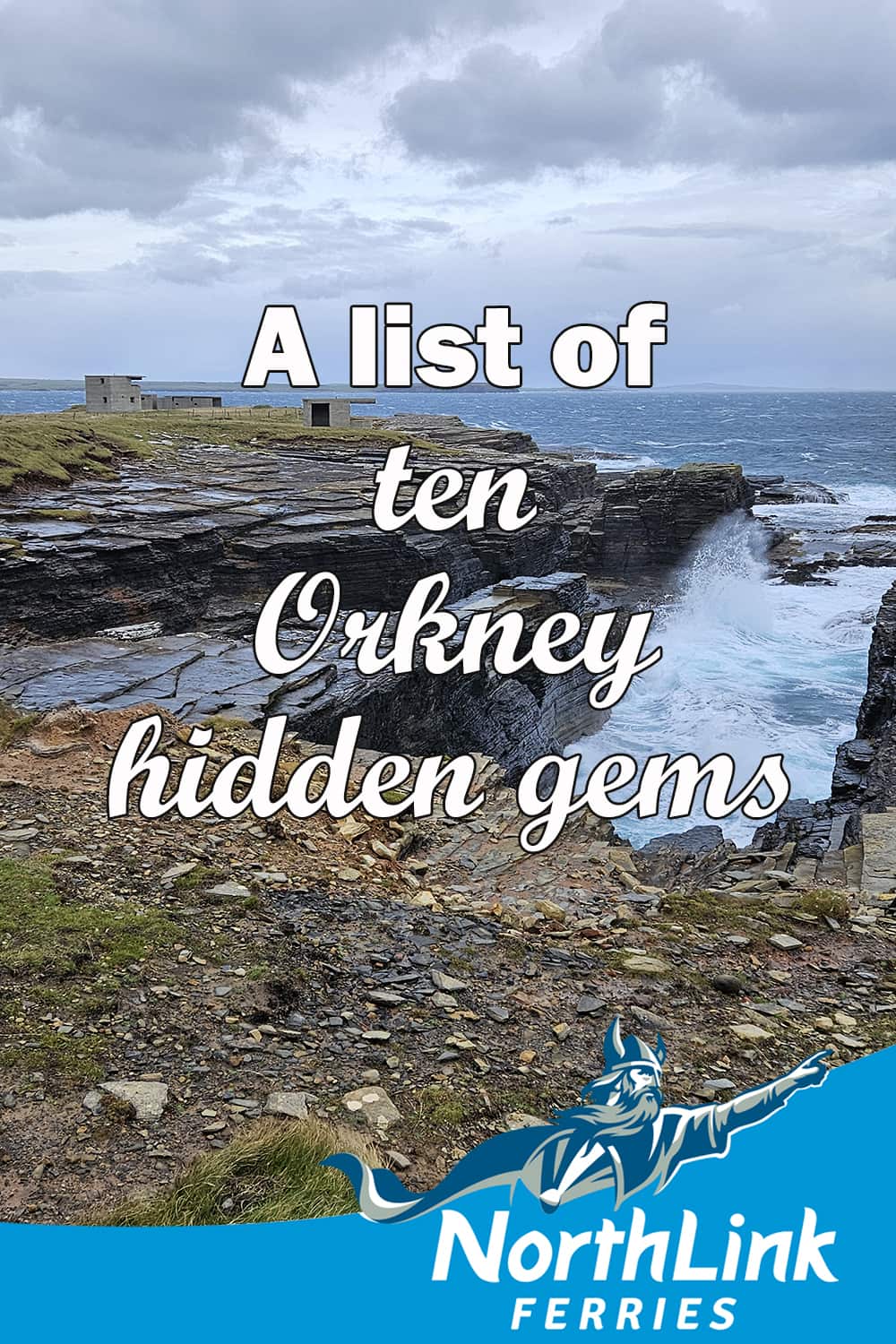A list of ten Orkney hidden gems
When you live in Orkney, you often find yourself, on a dry day, wondering about finding a new place to visit. There are hidden corners throughout the islands that even Orcadians, who might have lived here their whole lives, have never visited. This list, like all of our hidden gems guides (below) is written to encourage you to venture a little further, and to offer inspiration for visitors too. You might even discover your new favourite place!
Windwick bay is worth visiting with your camera in the winter months – it is one of the spots in Orkney where grey seals give birth to fluffy white seal pups.
Ten hidden gems of Orkney
Ten more hidden gems of Orkney
An extra ten hidden gems of Orkney
Ten further hidden gems of Orkney
Ten additional hidden gems of Orkney
Another ten hidden gems of Orkney
Ten new hidden gems of Orkney
Ten other hidden gems of Orkney
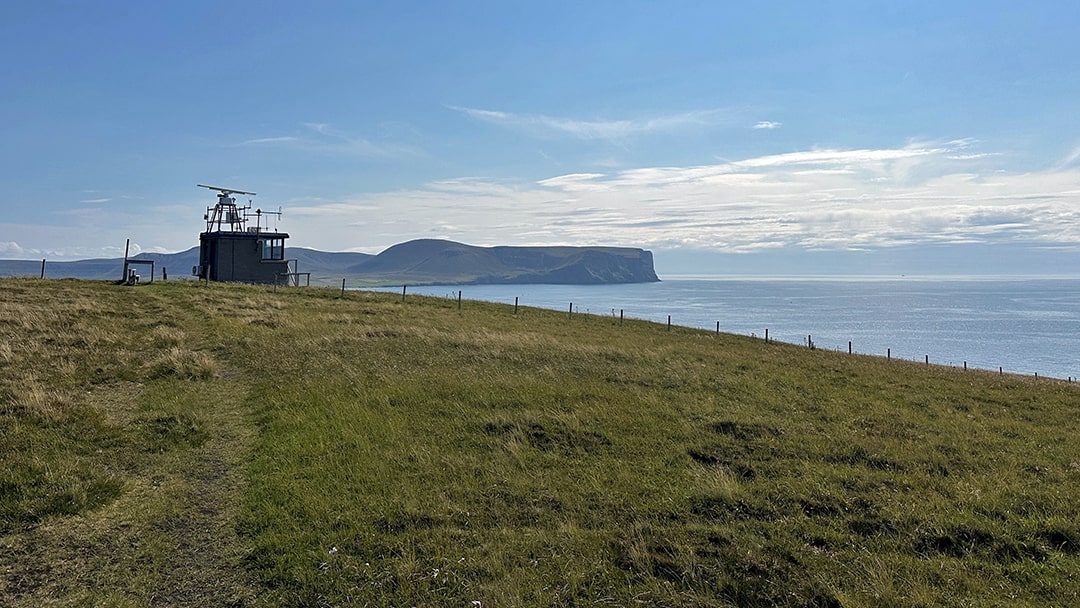
1) The Black Crag, Stromness
Just outside Stromness, beyond Warbeth beach, and along the west coast of the island there’s a steep hillside and cliff called the Black Crag. This hulking mass is one of the last sights you’ll have of mainland Orkney as you sail away on MV Hamnavoe, and it was once a useful navigation aid for seamen.
To reach the Black Crag, there’s a small car park (wide enough for two cars) and then a steep walk uphill. The artist Sylvia Wishart once lived in a house here called Heatherybraes, and she often painted the view of the Hoy hills from her sea window. On the way up you’ll pass through styles and gates – thankfully there are no treacherous barbed wire fences to clamber over! Eventually you’ll find yourself at the hilltop, amidst a wind and salt burnt landscape of yellow grass and brown heather. Only the toughest plants survive on these cliffs.
On the crest of the Black Crag, 111m above sea level, an old coastguard lookout station has been converted to monitor the tidal energy devices in the sea below the cliff. And about that cliff – there’s a rushing downward slope towards it, so care is needed – it’s hard to tell where the grass ends, and the cliff edge starts!
The footpath to the Black Crag is part of a longer trail which stretches northwards along the island’s western coast. The eleven miles from Stromness to Yesnaby covers some of Orkney’s best cliff scenery and is a very fine day out.
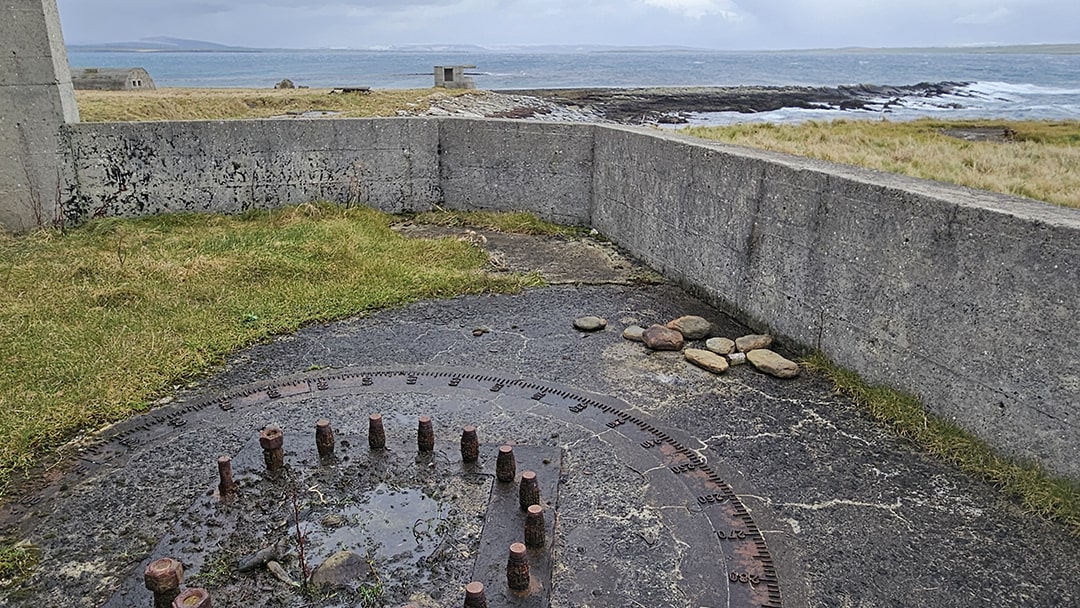
2) Rerwick Head Battery, East Mainland
Rerwick Head is the ideal location for wartime sea defences. This piece of land juts out of the East Mainland, with a wide view over the approach to Kirkwall. It takes a while to reach Rerwick Head by road and the last part of the journey is a rough track. When you arrive, you’ll find a place to park your car, and a fine circular walk which takes in the cluster of wartime buildings – we’d recommend going counterclockwise for a great view of the whole site. I visited on a stormy day with slate grey skies and a jostling wind, and watched waves crash over the low cliffs.
During both World Wars, Orkney was an anchorage for the British Fleet, and seaward-facing defences were built to prevent enemy attacks. The stretch of water at Rerwick Head was used to hold and inspect ships, up to 100 at a time, to make sure they weren’t carrying goods to Germany. Rerwick Head Battery has searchlight positions, a lookout tower and a gun emplacement. Though no longer installed here, the 6-inch seaward facing guns were salvaged from HMS Iron Duke. Entering the wartime buildings isn’t advised as they are quite unstable these days.
The metal ring for the gun emplacement is still visible. The numbers forged in metal are degrees, to assist the soldiers with finding their targets.
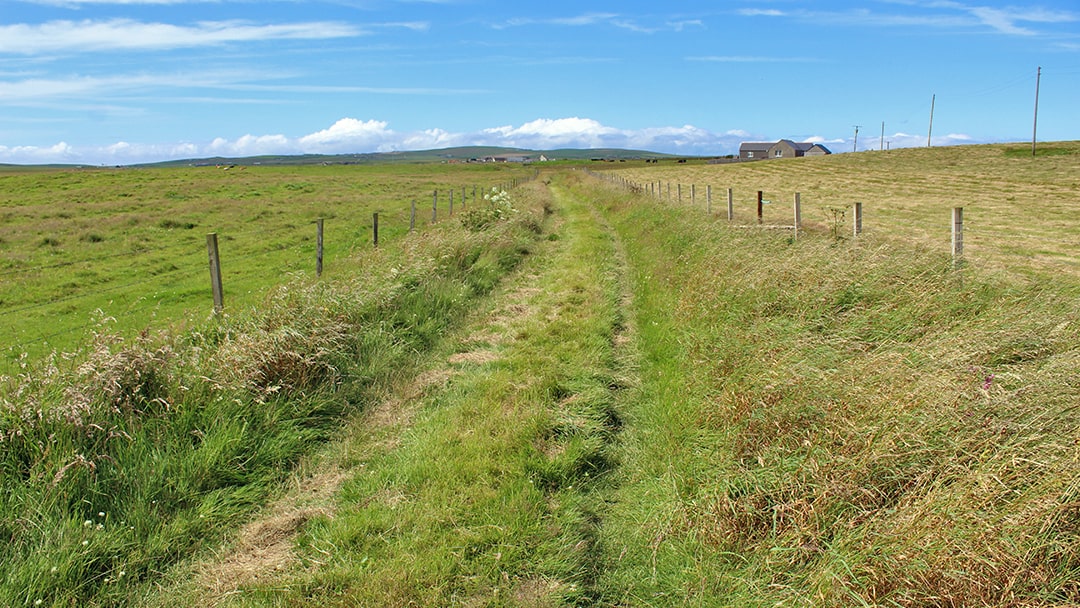
3) Swartland Drovers Road, Harray
Part of the old Birsay to Kirkwall road, this grassy track from Russland to Swartland passes the village of Dounby and some of the West Mainland’s best farming country. It is a fine walk for a spring or summers day. The road starts near the Merkister Hotel, and a signpost can be found opposite a small parking area. The track is mostly level, passing houses, fields full of cows and the massive Loch of Harray. My path was laid with little white wildflowers, eyebright, and the glitter of birdsong was in the air. Two horse riders passed – this quiet path is a safe place to ride horses, away from traffic.
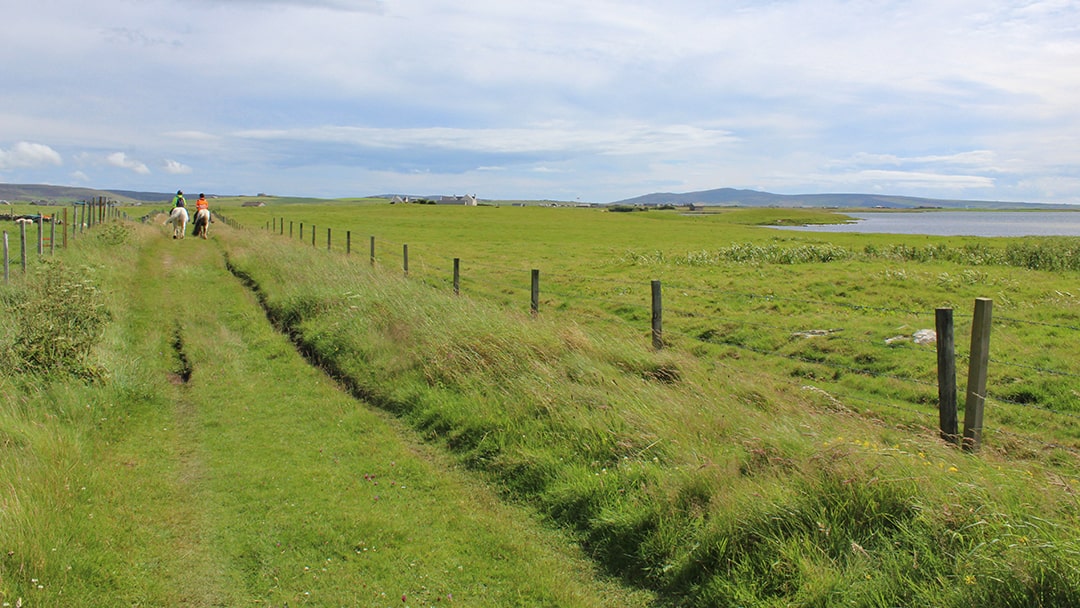
After a while, the grassy path meets a gravel road, and there’s a bridge to cross over a fast-flowing burn. The path meets a country road, the B9057, and at the other side, the second part of the Drovers Road is a little rougher. Rabbits flew into the fields and butterflies flittered along in front of me. In a field to my right there was the ruin of an old croft, and below it, an old church.
Eventually I reached Swartland, next to the entrance to Skeabrae, a wartime airbase. All in all, the walk, which is around 2 miles, took 50 minutes, and is equally as lovely in reverse!
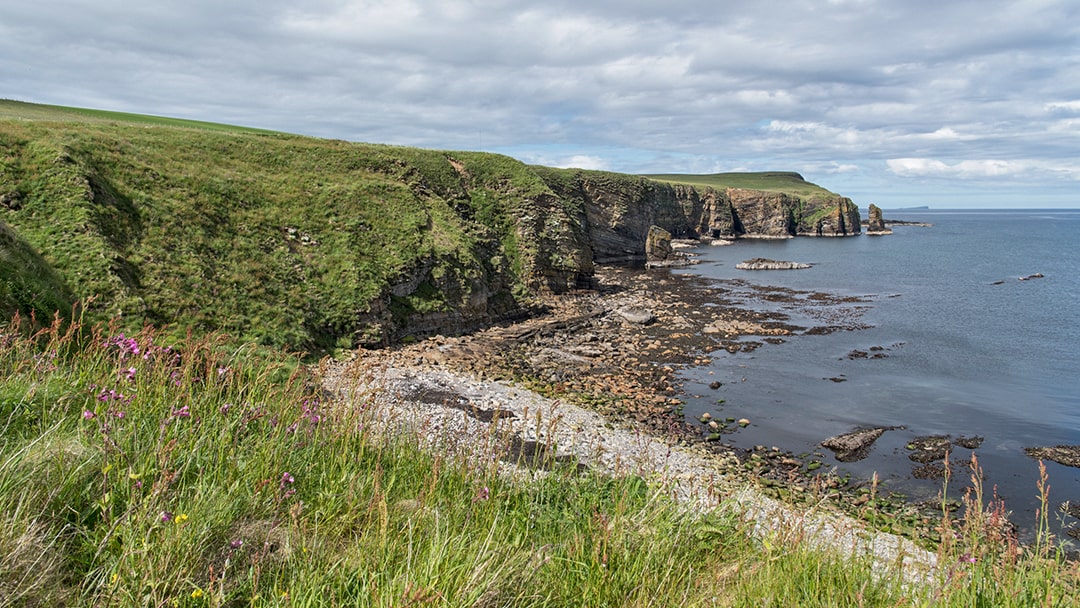
4) Windwick Bay and Hesta Head, South Ronaldsay
On a sunny day, Windwick in South Ronaldsay is a picturesque stony bay, and we’d recommend the bracing clifftop walk from here, which passes sea stacks and leads on to the 90m high cliffs at Hesta Head. It is hard to imagine how the area might look in darkness during a blizzard, like the conditions of 12th January 1918. On that night, the weather swiftly deteriorated whilst two British warships, HMS Opal and HMS Narborough, were searching for German minelayers to the east of Orkney. As they returned home in the gale and blinding snow at a speed of around 7 knots, the ships ran into the cliffs of Hesta Head and quickly sank, one after the other.
The poor weather conditions meant that a rescue effort couldn’t be made until the following morning, and only one crew member out of 189 survived. Gunner AB William Sissons climbed ashore, sheltered in a crevice and survived on snow and shellfish for two days before being rescued by a trawler. There’s a poignant memorial to the tragedy at the Windwick bay car park.
Windwick bay is worth visiting with your camera in the winter months – it is one of the spots in Orkney where grey seals give birth to fluffy white seal pups.
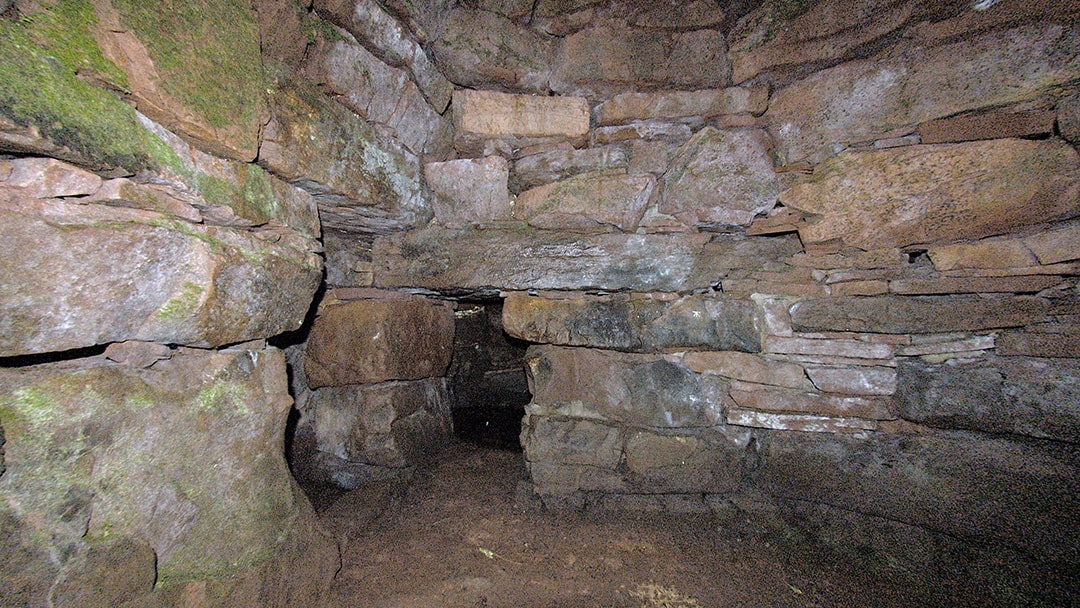
5) Vinquoy Hill Chambered Cairn, Eday
It makes me very happy to remember the day my late father and I explored Eday on foot, beginning at the Stone of Setter, and then on to the red sandstone cliff, the Red Head. Between those two landmarks we found the small 4,000-year-old tomb on Vinquoy Hill – so well camouflaged under the brown heather that it can easily be missed!
Vinquoy Hill Chambered Cairn is unique in that it was built with large blocks of red sandstone; the same colour as St Magnus Cathedral! It also resembles other Neolithic tombs in Orkney such as Maeshowe. For starters, there’s a 4m long low passageway to enter the tomb, and visitors will need to crawl inside. The tomb has a 3m high interior and four side chambers which are each 1½ m high. Vinquoy Hill Chambered Cairn is just one of many tombs on Eday.
We’d highly recommend visiting Vinquoy Hill Chambered Cairn, and the Stone of Setter, the Red Head, Carrick House and the red-throated divers on Mill Loch – really the whole island of Eday is a hidden gem!
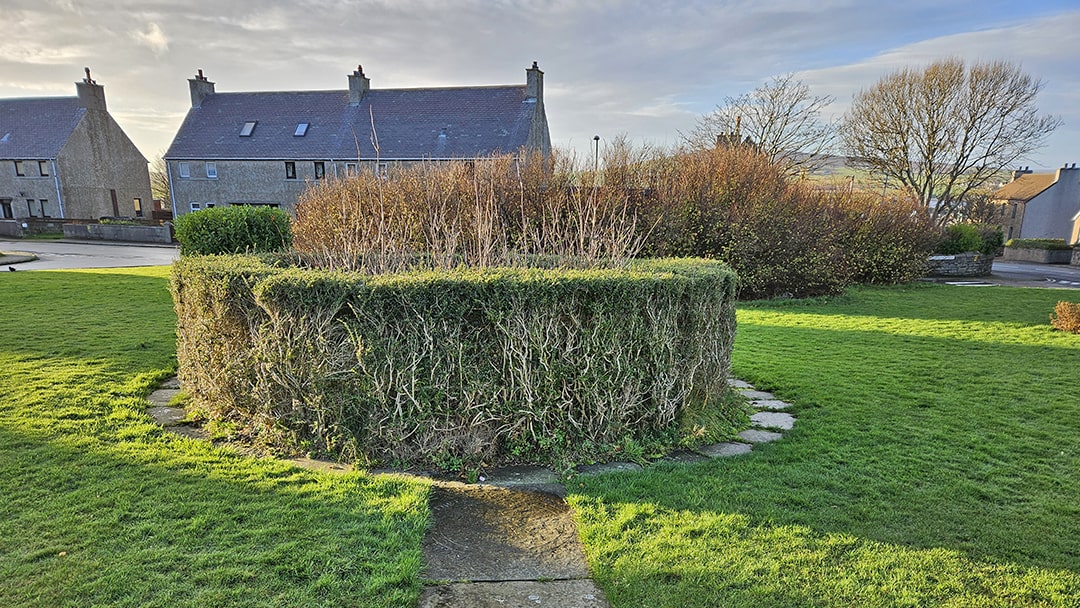
6) Gallowsha’, Kirkwall
A slightly grim hidden gem, but we like the sentiment on the memorial found here. Gallowsha’ in Kirkwall is a grassy patch at the top of Clay Loan, up the hill from St Magnus Cathedral, and it’s hard to believe that this tranquil spot was once a place of misery. Gallowsha’ was where criminals were once executed at the stake or by hanging. The last person to be executed in Orkney was a young servant girl, and alleged child murderer, Marjory Meason, who was hung in 1728. The hangman’s ladder can be glimpsed during a tour of the upper levels of St Magnus Cathedral.
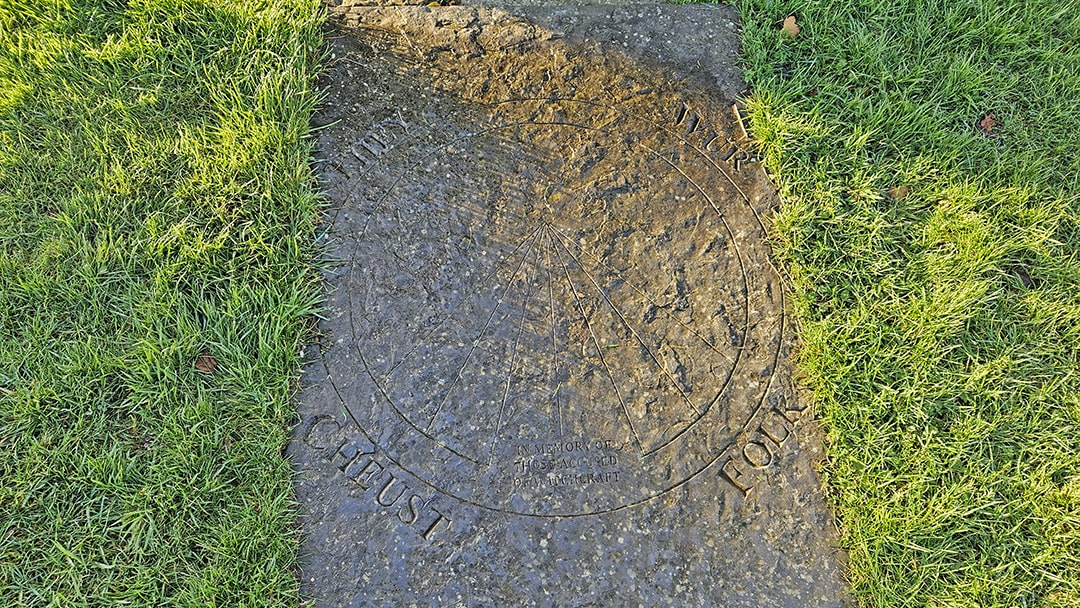
Between 1553 and 1736, around 70 innocent women, girls and a few men too, were accused of witchcraft and persecuted. Perhaps they had a quirk of character or a blemish which drew parish gossip and worse. Many were executed here at Gallowsha’. There is now a paving stone inscribed with a tribute to those victims which rightly declares ‘they wur cheust folk’.
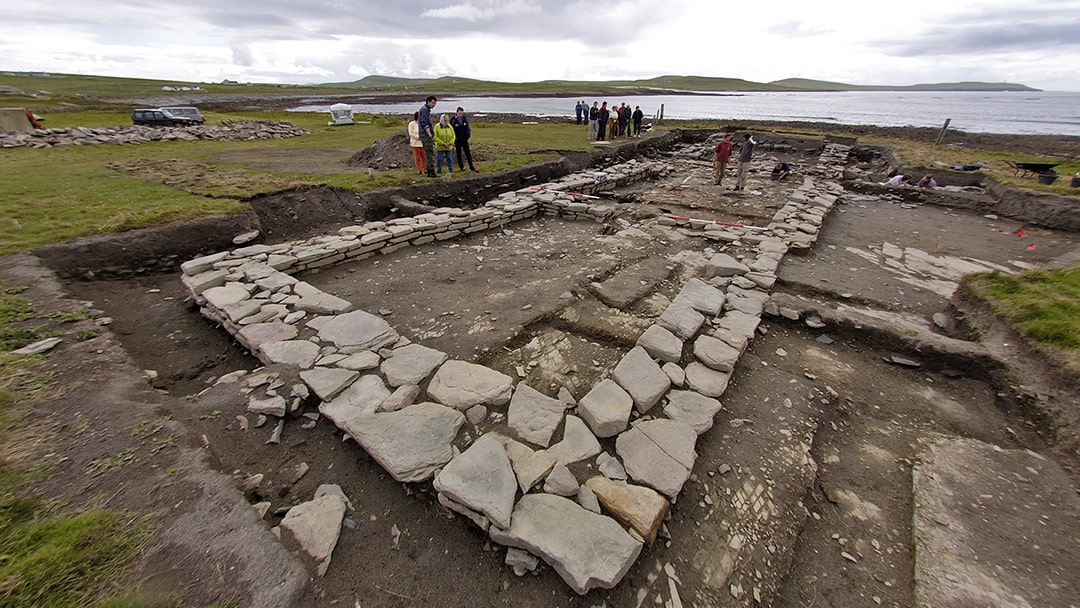
7) Quoygrew, Westray
Quoygrew was a settlement for over 1,000 years on the island of Westray. It’s on the shore, a little north of Pierowall and facing Noup Head. Only the outlines of the walls at Quoygrew remain, but it’s possible to imagine the occupants inside, lit by peatfire and fish oil lamps. These buildings were first occupied in 950 AD, some time after Norse settlers first came to be in Orkney. During the 12th century the structure was extended. Archaeologists found implements of daily life which had been imported from Scandinavia from this time.
16th century pottery from the Netherlands was found. Either the residents of Quoygrew were well-travelled, or they opened their doors to visitors from all over the world. By the 1930s the building was a small croft belonging to larger farm of Trenabie. The last tenants farmed a few acres, and they fished and made kelp until they vacated the property in 1937.
Quoygrew is important to archaeologists because it is one of only a few Norse houses still left in Orkney.
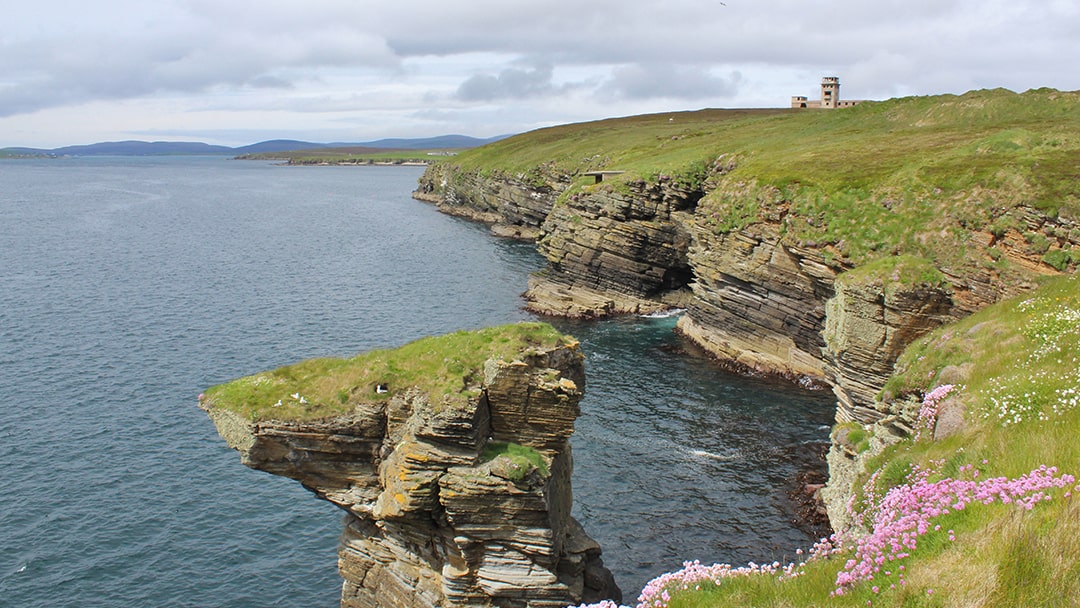
8) Stanger Head, Flotta
Stanger Head is one of the tallest areas of the flat island of Flotta. The towering Port War Signal Station there (which co-ordinated shipping movements and operated as fire command for nearby gun batteries) can be seen from miles around. However, the approach to Stanger Head is a little unappealing – you’ll be greeted by the ruins of a large, abandoned quarry. Amidst the rubble was once a large complex, crowded with accommodation buildings, a hospital, a dentist, an air raid shelter and defensive guns.
All of that is gone now, and the stone pulled from the quarry was used to make the Flotta oil terminal. There’s still something nice about the large pools of water left behind, and as you approach the green cliffs, the view become significantly more attractive. We were quite taken by the interesting shapes of the two sea stacks, the Cletts.
The jetty nearby was named ‘Kings Hard’ following a visit from King George V on 9th July, 1915. He came to inspect the troops that had gathered from Stanger Head and many of the other Orkney garrisons.
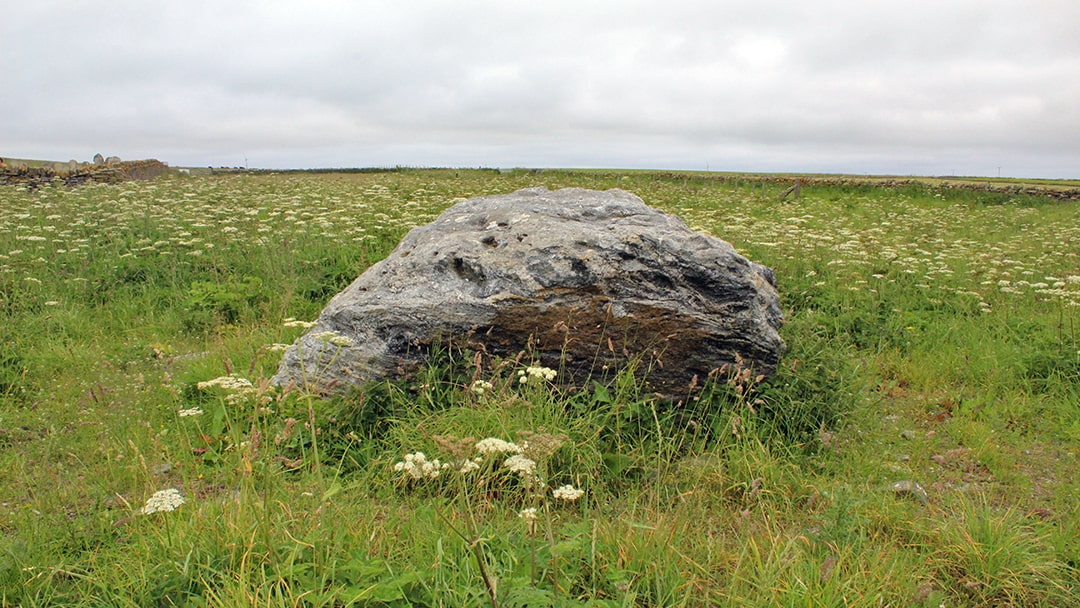
9) The Stone of Scar, Sanday
On the far north coast of Sanday there’s an area dramatically named Scar (from the Old Norse ‘skor’, meaning rim, edge or seashore). Most famous for the Viking boat burial uncovered nearby, there’s also an impressive Laird’s house at Scar, a graveyard, and a massive dark stone, called the Stone of Scar (or the Saville Stone). This rock is made of gneiss and weighs 16 tonnes in all. Orkney folklore tells of an Eday witch who threw the stone at her daughter, who had run away with her lover to Sanday.
The truth is more interesting – the Stone of Scar was carried to the island by a glacier, all the way from Norway, in the last Ice Age. It originally lay in a field belonging to the house of Saville one mile away. However, sometime in 1879 or 1880, the Laird decided the stone would make a good landscape feature and it was transported by cart to his house at Scar. Unfortunately, during the journey, the cart shattered under the heavy load, and the stone remains where it landed. Parts of the cart are still underneath!
Did you know? The mansion house of Scar is said to be haunted! The story goes that, whilst on his travels, an evil Laird at Scar married a lady from India. As they sailed back to Orkney, the Laird began to fear the reception he would receive at home, so pushed his poor wife overboard. From that day on, he was tormented by her ghost.
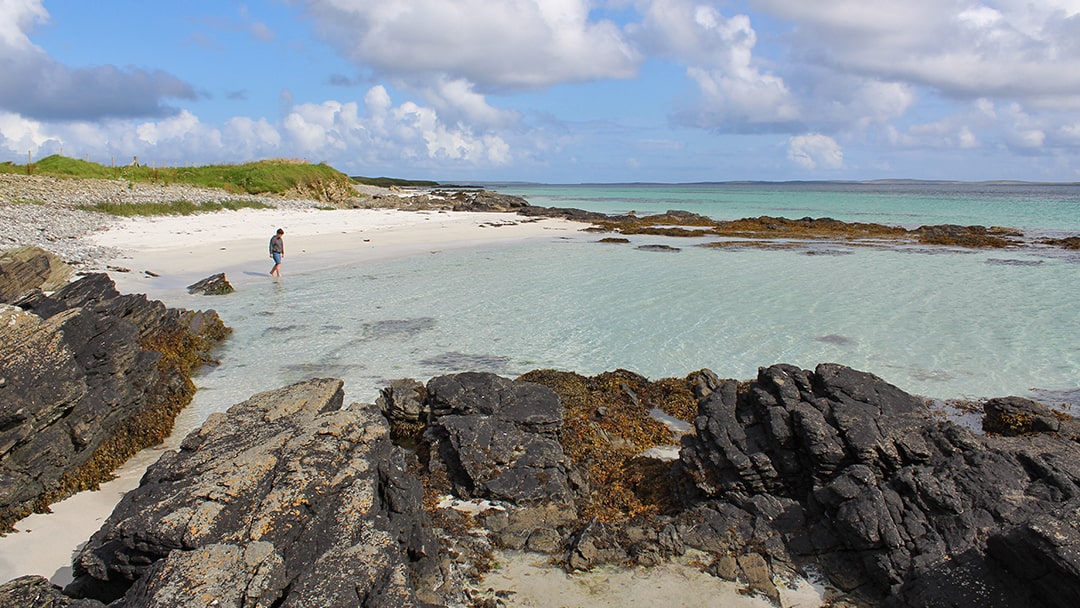
10) Canquoy beach, Egilsay
On the east coast of Egilsay – the opposite side of the island from the St Magnus Church, there’s a little beach at Canquoy and I believe it to be one of the finest in Orkney. There’s a grassy ledge above the beach with a small bench for picnics (I can’t imagine a finer dining spot – not even The Ivy could compare!) Below a small pebbly slope lies the finest white sand and turquoise water this side of the tropics.
There are rocky ledges and nooks to explore where the cold fingers of the tide rush in. We enjoyed rolling up our trouser legs and splashing along this idyllic sandy coast. We were watched by seals and have been told the beach is popular with otters too. The beach at Canquoy looks across to Eday – a busy shipping lane for ferries travelling to and from the north isles.
We recommended it to friends taking a trip to Egilsay and they loved it too – agreeing with our high opinion of Canquoy beach – which is one of the finest hidden gems in Orkney!
 By Magnus Dixon
By Magnus DixonOrkney and Shetland enthusiast, family man, loves walks, likes animals, terrible at sports, dire taste in music, adores audiobooks and films, eats a little too much for his own good.
Pin it!